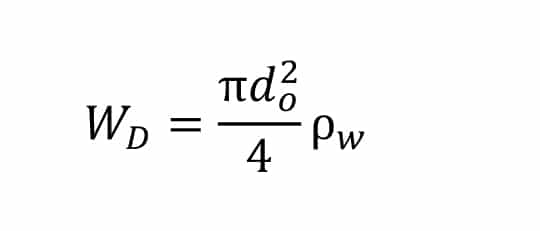AQUATHERM AND BUOYANCY
When it comes to aquatic applications, there are many advantages to using Aquatherm pipe rather than metallic piping. One of the most significant advantages is that Aquatherm pipe is corrosion resistant making it an ideal material to be used in harsh, underwater environments. Other advantages include the leak-free joints, made possible by the heat fusion process, and
the flexible and ductile properties of PP-R.
The flexible nature of PP-R is important when placing the pipe at the bottom of a body of water, with a potentially unsettled surface. The flexibility of PP-R also simplifies the process and machinery needed to transition the pipe from land to water. The ductility of PP-R allows Aquatherm pipe to shift when experiencing forces that may be caused by waves, currents, and
shifting bedding at the bottom of the water.
Because the density of the Aquatherm pipe is the same as freshwater, which is 1000 kg/m3, and slightly below that of salt water, which is 1035 kg/m3, the pipe is not buoyant in freshwater and minimally buoyant in saltwater.
The buoyant force exerted by a pipe full of water can be calculated by adding the weight of the pipe and its contents and subtracting the weight of the water displaced by the pipe:
FB= (Wp+ WC) – WD
FB: Buoyant force (lb/ft)
Wp: Weight of pipe (lb/ft)
Wc: Weight of contents in pipe (lb/ft)
WD: Weight of water displaced by pipe (lb/ft)
The weight per foot of the pipe can be found in the pipe Product Ran:ge of the catalog or it can be calculated by multiplying the area of the pipe times the density of the pipe:

Pw: Density of water (lb/ft3)
do: Outer diameter of the pipe (ft)
SDR: Pipe SDR Value
The weight of the contents of the pipe can be found by multiplying the volume of the contents inside the pipe times the density of the contents:
Wc= Vc Pc
Vc: Volume inside the pipe occupied by the contents (ft3/ft)
Pc: Density of contents (lb/ft3)
The Product Offering pages in the catalog also list the capacity of the pipe in gallons per foot, which can be converted to weight per foot using the formula above.
The weight of the displaced water can be found by multiplying the volume of the pipe times the density of the water:

Pw : Density of water (lb/ft3)
If Aquatherm is intended to be used under water it needs to be weighted and fixed to the floor of the body of water. Aquatherm can easily be supported near the surface of the water or under water because it has a neutral buoyancy. Options for permanent anchoring may include, but are limited to, placing backfill on top of the pipe, if it has been placed in a trench, tie down straps, or using ballast weights.
In a direct –buried application where there is a concern for ground water floating the pipe, this would normally only be a concern with a completely fluidized bed which would allow pipe movement. If this is a possibility, then the anchor loads needed to hold the pipe in place can be determined by assuming approximately 20% of the weight of the pipe given in the tables in the catalog (assumes pipe is filled with water). Note that the actual value would depend on soil density, and a value of 60% would cover all cases but would be much more conservative and probably not realistic.
For example, if we are proposing to bury 16″ SDR 17.6 blue pipe, from the catalog we can find the weight of the pipe as 18.10 lb./ft., and there is 1000 ft. installed, the total weight of pipe is 18,100 lb. The buoyant force generated by this amount of pipe would be approximately 20% of the pipe weight, depending on soil density, or approximately 3620 lb. So, an anchor placed every 100 ft. (11 anchors including one at each end) would be needed to hold 330 lb. per anchor.
A fluidized bed would mean that there was so much water in the soil that the soil behaves like a fluid rather than soil, and can no longer support any load. Saturated soil has not reached this condition, except perhaps at the top layer of mud.
If we assume a pipeline is buried at 24-in. below the surface of the ground, the soil load above the pipe at the 24-in depth (to top of pipe) is sufficient to hold the pipe in place, even if the pipe is filled with air, provided the soil has not fluidized.
In a worst-case of perhaps 6 inches of mud at the surface, then add this height to the burial depth.
If the soil is not fluidized, then the weight of the soil (prism load) will be sufficient to hold the pipe in place assuming a burial depth of at least 6 inches. Note however that the minimum recommended burial depth is 24 inches to the top of the pipe.
For an H-20 truck load (AASHTO), the minimum depth would be 42 inches to the top of the pipe, and there would have to be sufficient drainage to ensure the bed never became fluidized.
Also note that the pipe depth should be below the frost line if there’s any chance of the fluid in the pipe freezing. While the pipe is freeze-tolerant, it is not intended to be subjected to internal freezing water repeatedly.